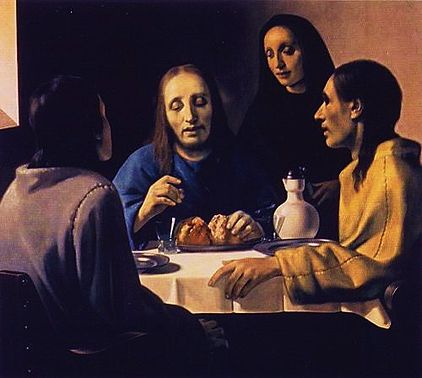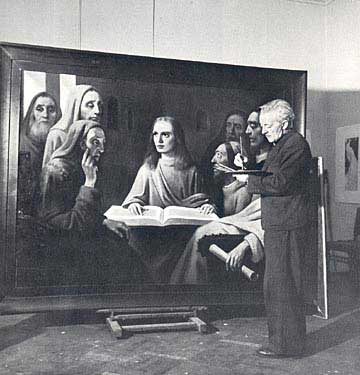Han van Meegeren (1889 – 1947) was a Dutch painter who began his career painting portraits of upper class Dutch people.
But frustrated with his limited success as a painter (critics called his work derivative) he turned to art forgery, imitating the styles of old masters, including Johannes Vermeer (1632 – 1675). Many museums and collectors paid tremendous amounts of money for his forgeries, making him rich.
His Supper at Emmaus, which was “discovered” in 1937, was hailed by art experts as one of the finest paintings Vermeer had ever painted. During the late thirties, several more “Vermeers” were discovered. This was exciting, because Vermeers are rare; there are only 36 of them known in the world. Here’s Supper at Emmaus, one of van Meegeren’s fake Vermeers:
 The Nazis invaded the Netherlands in 1940, and during the five-year occupation, many priceless works of art were acquired by Hitler and his second-in-command, Hermann Goering, who fancied themselves art experts. (The Nazis bought, stole, and looted artwork throughout Europe, from museums and private collections.)
The Nazis invaded the Netherlands in 1940, and during the five-year occupation, many priceless works of art were acquired by Hitler and his second-in-command, Hermann Goering, who fancied themselves art experts. (The Nazis bought, stole, and looted artwork throughout Europe, from museums and private collections.)
In 1945, the Allies captured Goering, and one of van Meegeren’s forged Vermeers was found in Goering’s huge art collection. Its sale was traced back to van Meegeren. Dutch officials, believing it to be a real Vermeer, had van Meegeren arrested as a Nazi collaborator. He was accused of selling Dutch property to the Nazis. Faced with life in prison or possibly the death penalty, van Meegeren confessed to having forged that and other paintings. He became famous immediately as one of the most audacious forgers ever.
It took some time to convince the authorities. He produced various glasses and jars from his own possessions that could be seen in his forged paintings. Because people still didn’t believe he’d painted the fake Vermeers, he had to paint another one while in police custody. Here’s a photo of him painting in front of witnesses:
During his trial, he explained his process, which had taken him years to perfect. He bought 17th century canvasses, and scraped off the top layer of paint. He mixed his own pigments using those approximating what the old masters would have used. And most ingeniously, he used bakelite (phenol formaldehyde) instead of oil paints, mixing it with the pigment. Bakelite is a liquid, and when you heat it, it hardens like a telephone. So after painting with the bakelite, he baked the paintings in the oven until the paint cracked. Then he washed them with diluted ink to blacken the cracks so the surface looked like it was three hundred years old.
From what I can tell, van Meegeren was a pretty unsavory guy. He had grown rich during a time when many Dutch people under Nazi occupation were starving. Having been snubbed (in his view) by Dutch art critics, he had put on exhibits of his work in Nazi Germany. Most damning, a book of his artwork was found in Hitler’s possession, containing a dedication to “My beloved Führer,” and inscribed by van Meegeren.
But in the two years between his arrest and the trial, he turned the tide of public sentiment in his favor. He became somewhat of a national hero: the cunning forger who had fooled not just the Nazis, but also the snooty art experts. He zoomed to the top of popularity polls.
Van Meegeren was convicted of forgery, and sentenced to a year in prison, but he died of a heart attack before he could serve out his sentence.
If you have twelve minutes to spare, here’s a fascinating overview of the story, narrated by an expert at the Boymans Museum.